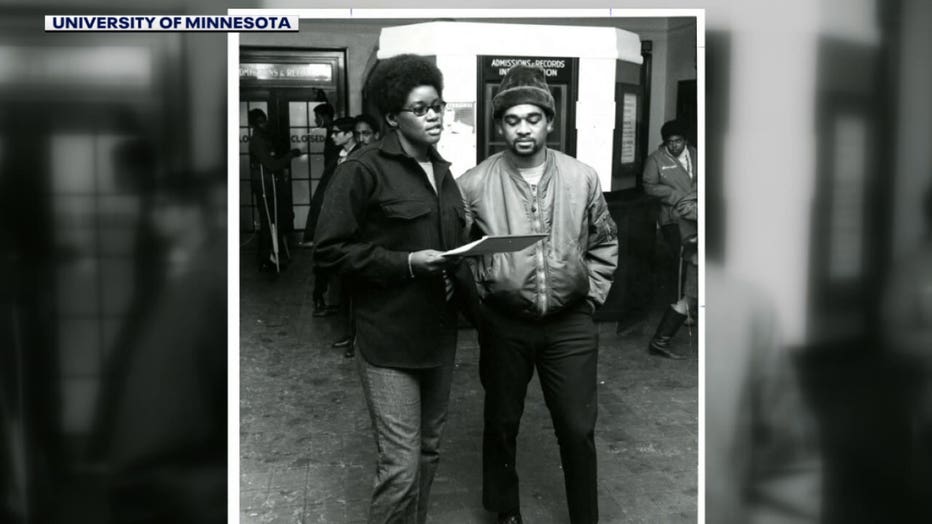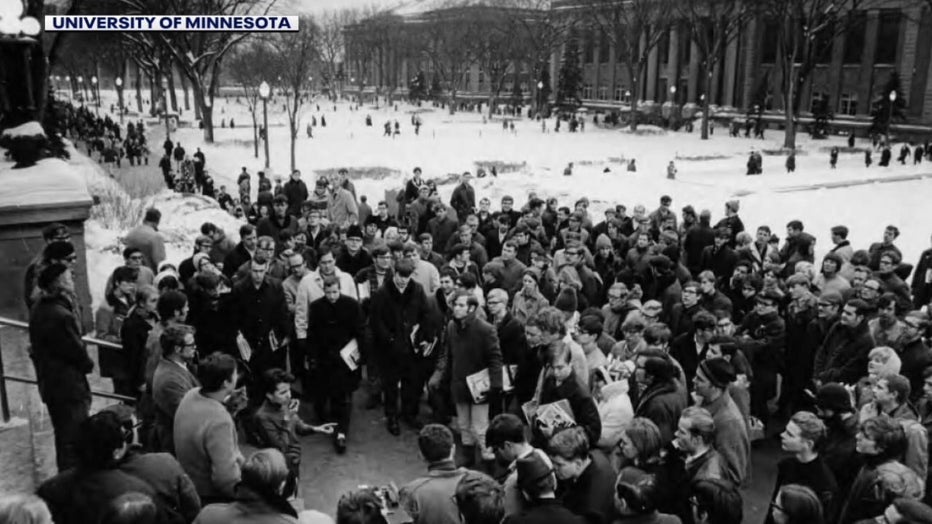Morrill Hall Takeover: The civil rights protest that changed the U of M
Lookback at the Morrill Hall takeover
The Northrop Mall is a historic landmark on the Twin Cities campus of the University of Minnesota. Among the buildings that shape the landscape is Morrill Hall, a building that is home to the university’s administrative offices but also the site of a significant moment in Black history.
MINNEAPOLIS (FOX 9) - The Northrop Mall is a historical landmark on the Twin Cities campus of the University of Minnesota. Among the buildings that shape the landscape is Morrill Hall, a building that is home to the university’s administrative offices but also the site of a significant moment in Black history.
In 1963, John Wright was a freshman at the University of Minnesota.
"There were a very, very small number of us African Americans on campus then. We could never count more than 80 or 90 on campus," said Wright during an interview with FOX 9's Bisi Onile-Ere.
He was raised in south Minneapolis and attending the U of M was part of his family legacy.
"And my father’s position was, he said, ‘I and your grandfather have been paying taxes to the state of Minnesota all of our lives to support that university. And although the university is doing things that have no legal or moral justification, in regard to our people, you have every right to go to that university,’" said Wright.
The well-documented struggle for equality on campus long preceded him. "For many years, because of university practices local Black parents oftentimes preferred to send their children to the historically Black colleges and universities rather than face discriminatory practices, insults and humiliation and marginalization at the university," said Wright.

(Supplied)
In 1968, there was a renewed push for change. At the time, Wright was a graduate student at the U of M. He was heavily involved in a Black student organization called the Afro-American Action Committee.
"Dr. King was assassinated on a Friday, and we met earlier in the following week trying to decide how we could respond in a way that would both honor Dr. King and contribute to reform on this campus," said Wright, who led the AAAC’s executive committee. "I wrote what became the seven demands that we then submitted to President Malcolm Moos and his administration," said Wright.
He says that months passed without a breakthrough.
"That’s when we decided to take nonviolent direct action in the manner of Dr. Martin Luther King," said Wright.
In January 1969, five Black students entered the U of M student records office and refused to leave. It would historically become known as the Morrill Hall Takeover. When asked what he recalls about that day.
"Well, a number of employees in the Bursar’s office were taken completely by surprise and didn’t know quite what to do. We were expecting that the police would be coming in short order," said Wright.
Wright was among about 70 students that he says were taking a peaceful stand. Photos capture the mood inside. Outside, the group was met with resistance.

The students at Morrill Hall faced confrontation during the takeover. (University of Minnesota / Supplied)
"There was immediate and intense reaction. There were a number of white student groups on campus, mostly conservative right-wing groups who immediately gathered around Morrill Hall and wanted to dislodge us if at all possible, some tried to break in," said Wright.
He says there was also a showing of support. "There were also white student groups, groups like the Students for a Democratic Society, and a number of others as well, who were allies who tried to provide a buffer to keep those other groups from physically and violently engaging us," said Wright.
Meantime, negotiations with U of M officials were underway.
"Some of the demands were first off, on a practical level, that 200 full scholarships be made available to underprivileged Black students," said Wright.
After 24 hours, the takeover ends. Their actions that day led to several new initiatives, including scholarships for Black students and the creation of the Department of Afro-American Studies. It's one of the first in the nation. "Our actions helped stimulate the creation of the nation’s first American Indians Studies Department here on campus. It led to the development of the women’s studies program and then the department, to Chicano studies, and so forth. So, it kind of had a ripple effect that way," said Wright.
More than 50 years after the Morrill Hall takeover, some aspects of campus remain the same, but a lot has changed. In 2022, the U of M's incoming freshman class was the most diverse, with Black and Indigenous students driving enrollment numbers. "We consider that to be progress in positive ways, but there’s still so much work to be done," said Wright.
A pioneer and activist, Wright’s push for equity and diversity became his life’s work.
"My professional goals were transformed by the movement. So, I would move from electrical engineering and a short stint in the MBA program, I would move into African, African American studies," said Wright.
A U of M Emeritus Professor, his career here would span decades. While plotting a path forward, he reminds us to look to the past. "My legacy is to have in some ways contributed to helping younger generations of Americans of all stripes and classes and colors, come to terms with the meaning of their history so that they can indeed help shape consciously create a healthier future," said Wright.
The arrests of the three students who led the Morrill Hall takeover sparked protests. Two students were convicted of unlawful assembly and served one-year probation. Another student was acquitted.

